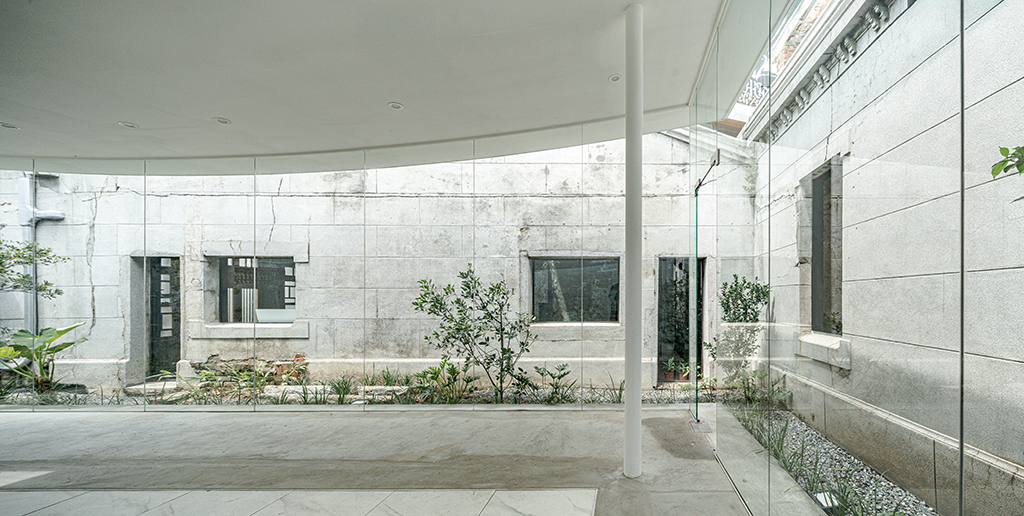Situated in the heart of Tainan’s historic Wutiaogang Cultural District, the Architecture Museum, Xinyi Street of Coral Stone—located at No. 13–17, Xinyi Street—stands near key cultural sites including Dueyue Gate, Jifu Temple, and the former Xin Fuxing Textile Factory. Originally built as the residence of Qing military scholar Hu Cheng-Yuan, it was reconstructed in the 1930s by Huang Sun-Kuai, combining traditional southern architecture with modern-era ornamentation.
The complex features two elongated townhouses and a central courtyard in the classic siheyuan layout, highlighting axial symmetry and open spatial layering. Years of neglect and alterations, however, left the structure in severe disrepair, requiring urgent intervention.
The revitalization follows a minimal intervention approach, reinforcing the structure while preserving its historical presence. A new transparent façade creates a spatial threshold—where coral stone walls meet glass and white volumes—framing the aged architecture behind like a filtered memory. Natural light, greenery, and carefully positioned voids evoke the unique sensory atmosphere of Tainan, where past and present engage in quiet dialogue.
On the upper floor, a modern wooden folded-plate roof redefines the spatial rhythm. The ridgeline, resembling a pulsing wooden heart, introduces light and breathability into the structure. Within, old and new materials coexist in harmony—where timber grains and stone textures narrate a story of transformation and cultural continuity.
The Architecture Museum, Xinyi Street of Coral Stone is not merely a restored building—it is a living testament to the power of sensitive regeneration. Rooted in local history and reimagined through contemporary design, it reflects Tainan’s evolving identity and celebrates its architectural heritage.
信義街硓𥑮石黃宅位於臺南市中西區信義街十三、十五、十七號,座落於五條港文化園區核心,鄰近兌悅門、集福宮、金安宮及新復興紡織廠等歷史場域,環境富含人文底蘊。原為胡澄淵武舉人宅第,1930年代由黃孫快重建,建築規模宏大,裝飾講究,融合傳統與時代特色,具高度保存與再利用價值。主體由兩棟長屋與一座大合院構成,露台採四合院環繞式配置,強調中軸線與對稱美感,形塑穿透流動的空間層次。然歷經增改與歲月風蝕,空間區域閒置失修,建築結構嚴重劣化,需立即性的活化修復。
建築以活化再利用為最大目標,結構補強採最低限度介入策略,保留老屋原貌與記憶場域。外層圍牆引導人們穿越舊有歷史界線,步入現代透明的建築語彙,透過白色空間的玻璃帷幕,看見後方具有時間痕跡的建築立面,而縫隙、陽光與綠意彷彿一層濾鏡,感受屬於臺南特有的空間氛圍,新舊交織的張力與時間對話,成為老宅重生的一種宣示。
二樓透過新式木結構將空間做化整為零的整併,木構折板屋頂整合出開放展間,屋脊造型如律動木心臟,將光影與呼吸導入老宅。厚重檜木大門背後是建築文化的展示,新舊材質共存,紋理交融,信義街硓𥑮石黃宅站在過去的累積上,以現代的手法創造屬於未來的價值,這座宅邸不僅是百年記憶的建築標誌,更是專屬於臺南城市文化再生的建築美術館。


